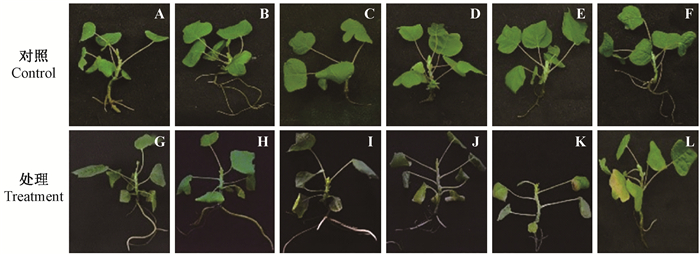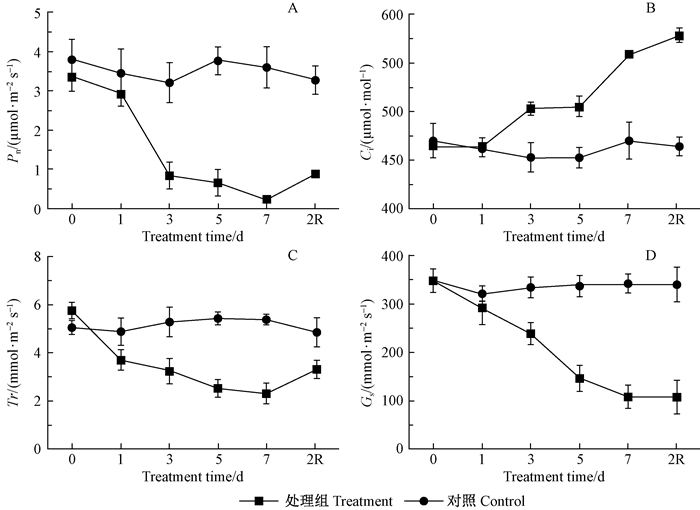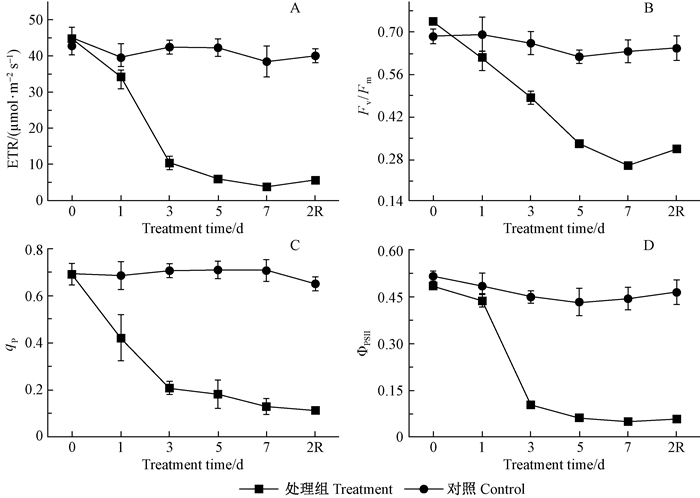文章信息
- 周艳威, 陈金慧, 鲁路, 成铁龙, 杨立明, 施季森
- Zhou Yanwei, Chen Jinhui, Lu Lu, Cheng Tielong, Yang Liming, Shi Jisen
- 杂交鹅掌楸体胚再生植株淹水胁迫下叶片超微结构及光合特性变化
- Changes on Leaf Chloroplast Ultrastructure and Photosynthetic Characteristics of Liriodendron sino-americanum Somatic Embryo Regeneration Seedlings under Waterlogging Stress
- 林业科学, 2018, 54(3): 19-28.
- Scientia Silvae Sinicae, 2018, 54(3): 19-28.
- DOI: 10.11707/j.1001-7488.20180303
-
文章历史
- 收稿日期:2017-03-11
- 修回日期:2017-10-19
-
作者相关文章
2. 南京林业大学南方现代林业协同创新中心 南京 210037;
3. 南京林业大学生物与环境学院 南京 210037
2. Co-Innovation Center of Sustainable Forestry in Southern China, Nanjing Forestry University Nanjing 210037;
3. College of Biology and the Environment, Nanjing Forestry University Nanjing 210037
洪涝灾害在我国是常见的自然灾害之一(顾西辉等, 2016),严重制约农作物以及林木的种植与推广,培育抗涝性强的林木品种是应对洪涝自然灾害和改良生态环境的有效途径。杂交鹅掌楸(Liriodendron sino-americanum)具有明显的杂种优势,生长快速、树形优美、花叶奇特,已广泛应用于园林绿化及精细木材加工。笔者课题组建立了稳定、高效的杂交鹅掌楸体细胞胚胎发生技术平台(陈金慧等, 2003),并实现了规模化的应用。但杂交鹅掌楸栽植在土壤含水量高及排水条件差的地方易根系腐烂,且不同无性系对环境胁迫的耐受力表现不一(潘向艳等, 2007; 孙志勇等, 2010),严重制约了其进一步推广应用。目前,有关于鹅掌楸的抗逆胁迫研究仅限于无性系涝害、干旱胁迫和臭氧胁迫等方面(潘向艳等, 2007; 2008;张晓平等, 2006; 孙志勇等, 2010),有关淹水胁迫对杂交鹅掌楸叶绿体超微结构影响及其与光合作用的综合分析研究还少有报道。
植物叶肉细胞内叶绿体等细胞器是植物受到胁迫后的重要反应场所,其超微结构的变化是植物逆境胁迫研究中的重要指标(Peharec et al., 2013; Ryang et al., 2009; Pareek et al., 1997)。淹水会导致不耐涝植物叶片获得光辐射强度降低,气孔闭合,从而影响光合作用(张阳等, 2011; Levitt, 1982),可通过光合叶绿素荧光相关参数判断植物是否受胁迫损伤(王秋姣等, 2012; 裴斌等, 2013)。本研究以杂交鹅掌楸体胚再生植株为试验材料,进行淹水胁迫处理,观察淹水胁迫下植株表型、叶肉细胞超微结构变化以及对光合作用的影响,为杂交鹅掌楸耐涝机制研究提供参考,也为鹅掌楸属植物抗性育种进一步应用推广提供理论基础。
1 材料与方法 1.1 试验材料以杂交鹅掌楸体细胞胚胎发生体系为基础平台,以2009年度建立的基因型为1×5002的胚性愈伤组织为试验材料进行体细胞胚胎发生诱导,成苗后转入3/4 MS基本培养基至植株高约5~6 cm。
1.2 淹水胁迫处理为初步探讨其耐水淹能力,预试验先将杂交鹅掌楸幼苗进行淹水胁迫处理预试验选取在3/4 MS固体基本培养基中生长健壮、高度为5~6 cm的杂交鹅掌楸体胚再生植株,在培养瓶中加入无菌水淹没植株模拟淹水胁迫,以不加无菌水处理的材料为对照,对照组和处理组各30株。将杂交鹅掌楸体胚再生植株置于恒温培养箱中进行淹水胁迫处理,每隔1天观察植株表型变化并记录,直至杂交鹅掌楸体胚再生植株基本全部死亡,根据植株表型变化将杂交鹅掌楸淹水伤害程度分为以下5个等级(王业遴等, 1990;张晓磊, 2010):0级:无伤害症状,植株正常;1级:下部叶片出现轻微卷曲;2级:除顶部叶片外,均出现卷曲,极少量基部叶片边缘开始呈黄化;3级:大部分叶片萎蔫,基部叶片黄化并在叶缘呈现褐斑;4级:绝大部分叶片有黄化和叶缘、叶尖褐斑,甚至叶片脱落。
根据前期耐涝试验结果,重新选取和预试验长势一致的杂交鹅掌楸体胚再生植株接种于培养瓶中,以正常培养条件下的植株作为对照组,以无菌水淹没植株模拟淹水胁迫。分别在淹水处理1、3、5、7天和7天后立即转入正常培养条件恢复培养2天时取待测植株的顶端叶片用以观察叶绿体超微结构变化,即每个胁迫处理时间对照组和处理组分别取15株待测植株。
1.3 植株表型及叶肉细胞超微结构观察分别在各胁迫处理时间对处理组和对照组植株的整株形态、叶片形态和颜色变化进行观察并拍照记录。参考罗玉兰等(2013)研究方法,采用透射电镜法观察杂交鹅掌楸叶片细胞超微结构的变化。
1.4 叶片光合作用和叶绿素荧光参数测定 1.4.1 叶片光合作用气体交换参数的测定在不同胁迫处理的早上8:00—10:00,参照Tworkoski等(2016)的方法(2016),用CIRAS-3光合测定系统测定处理组和对照组植株的从顶部数第3~4片完全展开叶片的净光合速率(net photosynthetic rate,Pn)、气孔导度(stomatal conductance,Gs)、细胞间CO2浓度(intercellular CO2 concentrations,Ci)、蒸腾速率(transpiration rate,Tr)。每个胁迫处理时间对照组和处理组分别取15株待测植株,每植株测定2片叶片,重复3次。
1.4.2 叶绿素荧光参数测定在不同胁迫处理的早上9:00将处理组和对照组植株置于暗处进行暗适应30 min,然后用德国WALZ公司生产的双通道脉冲可调叶绿素荧光仪DUAL-PAM-100测定叶绿素荧光参数,参照Yu等(2011)和Yang(2013)的方法测定光系统Ⅱ的光合电子传递速率(ETR)、光系统Ⅱ的最大光化学效率(the maximal photochemical efficiency of photosystemⅡ,Fv/Fm)、光系统Ⅱ的光化学实际量子产量(the photochemical quantum yield of photosystemⅡ,ΦPSⅡ)、光化学淬灭系数(the photochemicalquenching coefficient,qP)。每个胁迫处理时间对照组和处理组分别取15株待测植株,每待测植株测定2片叶片,重复3次。
1.5 数据分析使用SPSS 20.0统计软件进行数据分析。采用单因素方差分析(one way ANOVA)检验各胁迫处理时间测得数据与对照组的差异。用GraphPad Prism Version6.0(GraphPad software, La Jolla, CA, USA)对测定数据作变化趋势作图,图表中所示数据均为重复测定的平均值和标准误差。
2 结果与分析 2.1 淹水胁迫对杂交鹅掌楸体胚再生植株表型的影响随着淹水胁迫时间的延长,杂交鹅掌楸受到的胁迫伤害明显加剧(图 1和表 1)。淹水胁迫1天后,未出现明显淹水胁迫病害症状,第3天开始轻微的胁迫症状,8.9%的植株出现轻度的1级伤害,5天后出现比较严重的淹水胁迫伤害表型,分别有46.7%的植株为2级伤害和26.7%的植株为3级伤害,第7天植株出现更加严重迫害,叶片开始黄化,31.1%的植株为3级伤害,60%植株为最严重的4级伤害,第9天部分植株叶片黄化加重,脱落,84.4%出现4级伤害,甚至大部分植株死亡。初步判断杂交鹅掌楸体胚再生植株短期内对淹水胁迫最长耐受时间为9天。因此,将鹅掌楸淹水7天后,进行恢复培养,以期探讨杂交鹅掌楸对淹水胁迫的生理响应机制。

|
图 1 淹水胁迫处理对杂交鹅掌楸体胚再生植株影响 Figure 1 Phenotypes of Liriodendron sino-americanum somatic embryo regeneration seedlings under waterlogging stress A、B、C、D、E和F分别为对照组中杂交鹅掌楸体胚再生植株在1、3、5、7、9天和7天后未处理2天时植株表型;图G、H、I、J、K和L分别为处理组中杂交鹅掌楸体胚再生植株在淹水1、3、5、7、9天和7天后恢复正常培养2天时植株表型。 The phenotypes of control group on day1, 3, 5, 7, 9 and mock for 2 d after 7 d of L.sino-americanum seedlings are respectively shown in figure A, B, C, D, E and F. The phenotypes of L.sino-americanum seedlings under waterlogging stresson day 1, 3, 5, 7, 9 and 2 d recovery after 7 d are respectively shown in figure G, H, I, J, K and L. |
|
|
随着淹水胁迫时间的增加,杂交鹅掌楸体胚再生植株叶片胁迫伤害逐渐加剧(图 1)。与对照组(图 1A~F)相比,淹水胁迫处理1天后处理组杂交鹅掌楸植株整体生长基本正常(图 1G);胁迫处理3天后,杂交鹅掌楸植株除顶部2片叶片以外均出现了较轻微卷曲。顶芽和最上面2片叶片与对照相比生长正常(图 1H);胁迫处理5天时,处理组顶部叶片以下全部萎蔫,基部叶片开始出现黄化现象,顶部叶片和顶芽无萎蔫现象,植株与对照相比呈轻度萎蔫状(图 1I);胁迫处理7天时,处理组基部2片叶片黄化进一步加重,中部以下叶片开始出现褐色斑点,但顶芽无萎蔫,仍生长正常(图 1J);继续胁迫处理至第9天时植株叶片黄化严重,褐斑增多,基部叶片脱落,植株呈萎焉状,甚至死亡(图 1K);淹水胁迫处理7天后转移至正常培养条件2天,少部分顶部和中部叶片逐渐恢复至叶片伸展状,但中部以下叶片仍保持黄化和卷曲,叶片也有部分脱落,植株仍呈萎蔫状(图 1L)。
2.2 淹水胁迫对杂交鹅掌楸体胚再生植株叶肉细胞内叶绿体超微结构的影响超微结构的变化状况可作为鉴定植物抗涝性的细胞学指标(高兰阳等, 2010)。通过透射电镜对杂交鹅掌楸叶绿体超微结构的观察发现,随着淹水胁迫时间的延长,处理组体胚再生植株叶绿体逐渐出现脂质过氧化现象,叶绿体结构受一定程度破坏。由图 2可以看出,对照组中叶绿体呈纺锤形,膜结构清晰完整,基粒和基质类囊体片层排列整齐并与叶绿体长轴方向一致,叶绿体内基质片层间含有微量淀粉粒和嗜锇颗粒(图 2A);淹水胁迫处理1天后叶绿体内部基质和基粒片层间淀粉粒稍增多,出现大颗粒淀粉,基质和基粒片层排列较整齐,部分片层由于淀粉粒的增加出现排列松散不整齐的现象,嗜锇颗粒未见明显变化(图 2B);淹水盐胁迫处理第3天可见叶绿体内基粒片层间淀粉粒增大导致叶绿体形状膨胀变形,基粒和基质片层排列松散,极少部分基粒和基质片层出现溶解现象,嗜锇颗粒电子密度增大(图 2C);淹水胁迫处理第5天时,叶绿体由纺锤形变为不规则椭圆形,基粒和基质片层模糊,部分基质和基粒片层溶解,淀粉粒体积和数量增加,嗜锇颗粒数量增多(图 2D);淹水胁迫处理7天后,叶绿体呈不规则长圆形,基粒间淀粉粒聚集合体,基粒和基质类囊体片层大部分明显溶解,嗜锇颗粒聚集增多,与对照组相比,处理组叶绿体超微结构受到一定的破坏(图 2E);恢复正常培养条件2天后,处理组叶绿体未见明显恢复,基质和基粒片层模糊,大部分消失,叶绿体双层膜部分溶解导致叶绿体出现解体现象,淀粉粒减少,嗜锇颗粒聚集(图 2F)。

|
图 2 淹水胁迫处理对杂交鹅掌楸体胚再生植株叶肉细胞内叶绿体超微结构影响 Figure 2 Effect on chloroplast ultrastructure of L.sino-americanum somatic embryo regeneration seedlings under waterlogging stress A:对照组;B、C、D、E和F分别为杂交鹅掌楸在淹水处理1、3、5、7天和7天后恢复2天时叶绿体,Bar=2 μm;OG:嗜锇颗粒(白色箭头);S:淀粉粒;G:基粒片层;SL:基质片层;CW:细胞壁。 A: Control. Variation of chloroplast in 1, 3, 5, 7, and 2 d restore after 7 d of L.sino-americanum under waterlogging stress are respectively shown in figure B, C, D, E and F; Bar=2 μm.OG: Osmiophilic granules (white arrows); S: Starch grain; G: Grana lamella; SL: Stroma lamella; CW: Cell wall. |
净光合速率(Pn)是衡量植物在逆境条件下光合生理应激能力的重要参数(刘亚丽等, 2011)。细胞间CO2浓度(Ci)变化趋势是确定光合速率变化原因是否为气孔因素的重要依据(许大全, 1997; Farquhar et al., 1982)。蒸腾速率(Tr)在一定程度上反应了植物在逆境适应中调节水分损失的能力(韩蕊莲等, 1994)。气孔导度(Gs)是制约光合作用强度的重要因素之一,植物在胁迫条件下气孔导度通常会降低(曹福亮等, 2010)。因此光合作用参数的变化均反映了植物在胁迫环境中的光合作用能力的强弱,可作为判断植物光合作用是否受损的指标。
由图 3可知,与对照组相比,随着淹水胁迫时间的延长,杂交鹅掌楸体胚再生植株叶片净光合速率(Pn)、蒸腾速率(Tr)和叶片气孔导度(Gs)值均在处理前期缓慢下降,5天后出现急剧下降的趋势,并在处理7天或者恢复处理2天时达到最低值,但叶片细胞间隙CO2浓度(Ci)却出现前期缓慢上升,后期急剧上升的现象。恢复处理2天后所有光合特性参数指标均未出现明显恢复,处理组与对照组之间差异达到显著水平(P<0.05)。因此,推测淹水胁迫在短期内对杂交鹅掌楸的光合作用造成了一定程度的不可逆伤害。

|
图 3 淹水胁迫处理对杂交鹅掌楸体胚再生植株光合参数的影响 Figure 3 Effect on photosynthetic characters of L.sino-americanum somatic embryo regeneration seedlingsunder waterlogging stress A:净光合速率;B:细胞间CO2浓度;C:蒸腾速率;D:气孔导度;2R:恢复处理2天. A: Net photosynthetic rate; B: Intercellular CO2concentration; C: Transpiration rate; D: Stomatal conductance; 2R: 2 d recover |
电子传递速率(ETR)是表观光合电子传递速率,可反映光合能量的传递速率(Oxborough, 2004)。最大光化学效率(Fv/Fm)反映了植物PSⅡ潜在光化学活性的高低和PSⅡ利用光能的能力,是光抑制程度的重要依据(刘泽彬等, 2015; Demmig et al., 1996)。光化学淬灭系数(qP)是PSⅡ反应中心捕获光能用于光化学电子传递的大小,其值越大,电子传递活性越高,反映了PSⅡ反应中心的开放程度和电子传递活性的高低(刘泽彬等, 2015)。实际光化学量子效率(ΦPSⅡ)反映了PSⅡ反应中心在部分关闭情况下实际进行光化学反应的效率。上述光合作用参数的变化均反映了植物在胁迫环境中的光合活性的大小,可作为判断植物光合活性中心是否受损的指标。
由图 4可知,与对照组相比,淹水胁迫过程中杂交鹅掌楸体胚再生植株叶片光系统Ⅱ的电子传输速率(ETR)、光系统Ⅱ的最大光化学效率(Fv/Fm)、实际光化学量子效率(ΦPSⅡ)、光化学淬灭系数(qP)值均在淹水胁迫处理1天后呈现明显下降的趋势。其中,最大光化学效率(Fv/Fm)恢复处理2天后有所上升,其他叶绿素荧光参数指标均未出现恢复。差异显著性分析显示,处理组与对照组之间差异极显著(P<0.01)。因此,可推测短期淹水胁迫对杂交鹅掌楸体胚再生植株的光系统Ⅱ活性中心造成了不可逆的损伤,导致其光合作用能力下降。

|
图 4 淹水胁迫处理对杂交鹅掌楸体胚再生植株的光合叶绿素荧光参数的影响 Figure 4 Effect on chlorophyll fluorescence parameters of L.sino-americanum somatic embryo regeneration seedlings under waterlogging stress A:电子传递效率;B:最大光化学效率;C:光化学淬灭系数;D:实际光化学量子效率;2R:恢复处理2天。 A: Electron transport rate; B: The maximum photochemical efficiency; C: Photochemical quenching coefficient; D: The quantum efficiency of the photochemical; 2R: 2 d recovery. |
淹水胁迫对植物生长的伤害主要表现为:叶片变小、萎蔫、黄化、坏死,顶芽变化以及根系腐烂等现象。其中,叶片是与外界进行能量和物质交换的重要场所,对外界环境条件变化的反应最为敏感(Munns et al., 1986; 李军超等, 1989),在淹水后会呈现自下而上逐次变黄的衰老症状(连洪燕, 2008)。本研究中,杂交鹅掌楸体胚再生植株的叶片从基部往上逐步出现轻微卷曲、黄化、萎蔫,甚至叶片脱落等一系列相应的胁迫伤害表型,但顶芽未出现明显伤害症状。这说明杂交鹅掌楸苗可在淹水胁迫环境中通过保持顶芽的活力来维持植株的生长,这与多种植物的胁迫应激反应是一致的(李彦强等, 2015; 赵志新等, 2009; 陈鹭真等, 2006; 张晓平, 2004),使杂交鹅掌楸在淹水胁迫环境下具有一定的耐受力。
3.2 淹水胁迫对杂交鹅掌楸叶绿体超微结构的影响嗜锇颗粒由嗜锇物质和脂类物质构成,它的产生是类囊体膜降解脂质聚集的结果,不仅可以作为膜脂质的来源,也可提高细胞内渗透压,维持细胞的结构(Bejaoui et al., 2016)。淀粉粒是光合作用后碳水化合物主要的存在形式,水解后提供能量,还可作为蛋白合成的碳骨架,胁迫中细胞的代谢水平降低和应激反应均可造成淀粉粒的积累(Salama et al., 1994; Shinozaki et al., 1997; 李贤超等, 2014)。本研究中杂交鹅掌楸体胚再生植株叶绿体结构肿胀变形,片层结构松散,嗜锇颗粒增多,淀粉粒增加,膜结构破坏,恢复处理后未明显恢复,说明叶绿体膜系统在淹水胁迫中发生了不可逆的脂质过氧化,甚至膜降解,同时也产生了一系列的应激反应来抵抗胁迫,这表明杂交鹅掌楸短期内具有一定的耐水能力,这些结论与前人研究结果一致(段瑞军等, 2010; 杜克兵等, 2010; 王逸群等, 2008; 武乐乐, 2010; 钱莲文等, 2016; Ren et al., 2016; Palomäki et al., 1994)。
3.3 淹水胁迫对杂交鹅掌楸光合作用的影响植物对淹水后缺氧最敏感的响应就是气孔关闭,气孔导度下降,进而导致叶片吸收CO2的能力降低和蒸腾速率的下降,直接影响到与之密切相关的光合作用(Farquhar et al., 1982;Alberte et al., 1977)。而胁迫导致植物光合作用下降可以归于2种因素:一是气孔限制因素,即由于气孔关闭而阻碍CO2进入叶片;二是非气孔限制因素。其中,细胞间CO2浓度(Ci)的变化是其决定因素,气孔导度和光合速率下降的同时,若Ci也下降,则表明该植物光合作用的限制因子主要是气孔因素;如果Ci增加,则说明主要是非气孔因素(许大全, 1997)。本研究中,杂交鹅掌楸体胚再生植株的Pn、Gs和Tr都出现严重的下降,而Ci在胁迫1天后基本不变,甚至轻微下降的趋势,后期Ci不断增加,说明在淹水胁迫前期气孔因素是导致杂交鹅掌楸苗的光合速率下降的主导因素,随着胁迫时间的延长,Ci迅速升高,这些变化与中国鹅掌楸(Liriodendron chinense)的淹水胁迫变化一致(张晓平等, 2007),说明非气孔因素是胁迫后期光合速率下降的主要原因,结合叶绿体超微结构的损伤可推测,可能是作为光合作用主要场所的叶绿体遭受一定程度的不可逆伤害后,进而导致其光合速率的下降,这与小叶杨(Populus simonii)的淹水胁迫变化一致(杜克兵等, 2010)。
本研究还发现杂交鹅掌楸苗的气孔导度下降,蒸腾速率也大幅下降,并在胁迫7天后达到最低值,恢复处理后均未出现恢复现象,这说明杂交鹅掌楸苗在淹水胁迫后引起了气孔关闭,直接影响到与之密切相关的蒸腾作用,表明长时间的淹水胁迫会导致杂交鹅掌楸的气孔受到不可逆伤害,这与中华蚊母树(Distylium chinense)(刘泽彬等, 2014)和薄壳山核桃(Carya illinoinensis)(刘广勤等, 2012)的研究结论一致。
植物在逆境胁迫时光合作用受到抑制最初影响的就是PSⅡ,若叶绿体超微结构受到损伤,必然引起光合性能的下降,光合作用减弱,进而影响叶绿素荧光参数(Lu et al., 1999)。因此,叶绿素荧光参数的变化是评价植物光合作用机构受损与否的重要指标(杜克兵等, 2010; 吴华等, 2016),而且叶绿素荧光比气体交换参数的变化更能直接地反映植物光合作用机构是否受损(Krause, 2010)。本研究中,Fv/Fm、ΦPSⅡ、ETR和qP均比对照出现了显著下降,说明淹水胁迫对杂交鹅掌楸体胚再生植株光合作用机构造成了严重影响,使得光合电子传递过程受到抑制和损伤,引起了电子传输速率下降,光合作用减弱,这与小叶杨的淹水胁迫变化一致(杜克兵等,2010)。
4 结论完整的叶绿体结构是保证植物正常光合作用的前提。本研究发现杂交鹅掌楸叶绿体内基质和基粒片层的破坏以及叶绿体内膜的损伤程度与光合速率、气孔导度、叶绿体荧光参数的变化基本一致,说明淹水胁迫中叶绿体结构的破坏会导致PSⅡ光合反应中心受损,光合电子传递过程受到抑制,进而光能转换效率降低,是造成淹水胁迫过程中光合性能下降的直接原因,且随着胁迫时间的延长影响程度不断加深。恢复处理后均未出现明显恢复现象,说明长时间淹水胁迫对杂交鹅掌楸的叶绿体超微结构造成了一定程度的不可逆损伤,进而影响其光合作用,最终严重影响植株生长。因此,今后在杂交鹅掌楸体胚再生植株的栽培管理和多涝害地区推广应用过程中,须充分考虑土壤中水分含量的影响,不可长时间积水。
曹福亮, 蔡金峰, 汪贵斌, 等. 2010. 淹水胁迫对乌桕生长及光合作用的影响[J]. 林业科学, 46(10): 57-61. (Cao F L, Cai J G, Wang G B, et al. 2010. Effects of waterlogging stress on the srowth and photosynthesis of Sapium sebiferum[J]. Scientia Silvae Sinicae, 46(10): 57-61. [in Chinese]) |
陈金慧, 施季森, 诸葛强, 等. 2003. 杂交鹅掌楸体细胞胚胎发生研究[J]. 林业科学, 39(4): 49-53. (Chen J H, Shi J S, Zhuge Q, et al. 2003. Studies on the somatic embryogenesis of Liriodendron hybrids (L. chinense×L. tulipifera)[J]. Scientia Silvae Sinicae, 39(4): 49-53. [in Chinese]) |
陈鹭真, 林鹏, 王文卿. 2006. 红树植物淹水胁迫响应研究进展[J]. 生态学报, 26(2): 586-593. (Chen L Z, Lin P, Wang W Q. 2006. Mechanisms of mangroves waterlogging resistance[J]. Acta Ecologica Sinica, 26(2): 586-593. [in Chinese]) |
杜克兵, 许林, 涂炳坤, 等. 2010. 淹水胁迫对2种杨树1年生苗叶片超微结构和光合特性的影响[J]. 林业科学, 46(6): 58-64. (Du K B, Xu L, Tu B K, et al. 2010. Influences of soil flooding on ultrastructure and photosynthetic capacity of leaves of one-year old seedlings of two poplar clones[J]. Scientia Silvae Sinicae, 46(6): 58-64. [in Chinese]) |
段瑞军, 胡新文, 符少萍, 等. 2010. 盐胁迫下海马齿叶肉细胞超微结构观察[J]. 热带作物学报, 31(3): 397-403. (Duan R J, Hu X W, Fu S P, et al. 2010. Ultrastructural observation of mesophyll cells of salt-stressed Sesuvium portulacastrum L.[J]. Chinese Journal of Tropical Crops, 31(3): 397-403. [in Chinese]) |
高兰阳, 李洪泉, 陈涛, 等. 2010. 植物对涝渍响应的研究进展[J]. 草业与畜牧, 171(2): 1-5. (Gao L Y, Li H Q, Chen T, et al. 2010. A review of the response to waterlogging stress of plant[J]. Prataculture & Animal Husbandry, 171(2): 1-5. [in Chinese]) |
顾西辉, 张强, 张生. 2016. 1961-2010年中国农业洪旱灾害时空特征、成因及影响[J]. 地理科学, 36(3): 439-447. (Gu X H, Zhang Q, Zhang S. 2016. Spatio-temporal properties of flood/drought hazards and possible causes and impacts in 1961-2010[J]. Scientia Geographica Sinica, 36(3): 439-447. [in Chinese]) |
韩蕊莲, 梁宗锁, 侯庆春, 等. 1994. 黄土高原适生树种苗木的耗水特性[J]. 应用生态学报, 5(2): 210-213. (Han R L, Liang Z S, Hou Q C, et al. 1994. Water consumption properties of adaptable nursery stocks on loess plateau[J]. Chinese Journal of Applied Ecology, 5(2): 210-213. [in Chinese]) |
李军超, 陈一鹗, 康博文, 等. 1989. 宁夏盐池县草原常见植物同化枝解剖结构观察[J]. 西北植物学报, 9: 191-196. (Li J C, Chen Y E, Kang B W, et al. 1989. Anatomical observation of assimilatine branches of some species in Yanchi county, Ningxia[J]. Acta Botanica Boreali-occidentalia Sinica, 9(3): 191-196. [in Chinese]) |
李贤超, 吴友根, 杨东梅, 等. 2014. 海南广藿香叶肉细胞超微结构对盐胁迫的响应[J]. 江西农业大学学报, 36(2): 300-304. (Li X C, Wu Y G, Yang D M, et al. 2014. Respond of salt stress on ultrastructure of mesophyll cells in Pogostemon cablin[J]. Acta Agriculturae Universitatis Jiangxiensis, 36(2): 300-304. [in Chinese]) |
李彦强, 高柱, 孙小艳, 等. 2015. 淹水胁迫下北美鹅掌楸幼苗形态和生长的响应. 西南林业大学学报, 35 (3): 8-13. (Li Y Q, Gao Z, Sun X Y, et al. 2015. Response on morphology and growth of seedlings of Liriodendron tulipifera under submergence, 35(3): 8-13. [in Chinese]) |
连洪燕, 2008. 石楠属植物幼苗对淹水胁迫的响应. 南京: 南京林业大学硕士毕业论文.
|
Lian H Y. 2008. Responses of Photinia plants seedlings to waterlogging stress. Nanjing: MS thesis of Nanjing Forestry University. [in Chinese]
|
刘广勤, 朱海军, 周蓓蓓, 等. 2012. 旱涝胁迫对薄壳山核桃光合特性和叶绿体超微结构的影响[J]. 江苏农业学报, 28(6): 1429-1433. (Liu G Q, Zhu H J, Zhou B B, et al. 2012. Effects of drought and flooding stress on photosynthetic characteristics of pecan Carya illinoinensis Wangenh and ultrastructure of its chloroplasts[J]. Jiangsu Journal of Agricultural Sciences, 28(6): 1429-1433. [in Chinese]) |
刘亚丽, 王庆成, 杨远彪, 等. 2011. 水分胁迫对脂松幼苗生长和光合特性的影响[J]. 东北林业大学学报, 39(4): 33-36. (Liu Y L, Wang Q C, Yang Y B, et al. 2011. Effects of water stress on growth and photosynthetic characteristics of red pine seedlings[J]. Journal of Northeast Forestry University, 39(4): 33-36. [in Chinese]) |
刘泽彬, 程瑞梅, 肖文发, 等. 2014. 模拟水淹对中华蚊母树生长及光合特性的影响[J]. 林业科学, 50(9): 73-81. (Liu Z B, Cheng R M, Xiao W F, et al. 2014. Effect of flooding on growth, photosynthesis and fluorescence characteristics of Distylium chinense[J]. Scientia Silvae Sinicae, 50(9): 73-81. [in Chinese]) |
刘泽彬, 程瑞梅, 肖文发, 等. 2015. 遮荫对中华蚊母树苗期生长及光合特性的影响[J]. 林业科学, 51(2): 129-136. (Liu Z B, Cheng R M, Xiao W F, et al. 2015. Effects of shading on growth and photosynthetic characteristics of Distylium chinense seedlings[J]. Scientia Silvae Sinicae, 51(2): 129-136. [in Chinese]) |
罗玉兰, 张国兵, 张爱明. 2013. '金边'北美鹅掌楸不同叶色结构特征比较[J]. 植物研究, 33(3): 282-286. (Luo Y L, Zhang G B, Zhang A M. 2013. Comparison of leaf structures in the green and yellow parts of Liriodendron tulipifera 'aureomarginatum'[J]. Bulletin of Botanical Research, 33(3): 282-286. [in Chinese]) |
潘向艳, 季孔庶, 方彦. 2007. 淹水胁迫下杂交鹅掌楸无性系几种酶活性的变化[J]. 西北林学院学报, 22(3): 43-46. (Pan X Y, Ji K S, Fang Y. 2007. Changes in enzyme activities in different clones of Liriodendron Chinense×L. tulipifera under flooding stress[J]. Journal of Northwest Forestry University, 22(3): 43-46. [in Chinese]) |
潘向艳, 季孔庶, 方彦. 2008. 淹水胁迫下杂交鹅掌楸无性系叶片内源激素含量的变化[J]. 南京林业大学学报:自然科学版, 32(1): 29-32. (Pan X Y, Ji K S, Fang Y. 2008. Changes in contents of endogenous hormones in different clones of Liriodendron Chinense×L. tulipifera under flooding stress[J]. Journal of Nanjing Forestry University:Natural Sciences Edition, 32(1): 29-32. [in Chinese]) |
裴斌, 张光灿, 张淑勇, 等. 2013. 土壤干旱胁迫对沙棘叶片光合作用和抗氧化酶活性的影响[J]. 生态学报, 33(5): 1386-1396. (Pei B, Zhang G C, Zhang S Y, et al. 2013. Effects of soil drought stress on photosynthetic characteristics and antioxidant enzyme activities in Hippophae rhamnoides Linn[J]. seedings. Acta Ecologica Sinica, 33(5): 1386-1396. [in Chinese]) |
钱莲文, 吴文杰, 孙境蔚, 等. 2016. 铝胁迫对常绿杨生长及叶肉细胞超微结构的影响[J]. 林业科学, 52(11): 39-46. (Qian L W, Wu W J, Sun J W, et al. 2016. Growth characteristics and leaf ultrastructures of evergreen poplar clone under aluminum stress[J]. Scientia Silvae Sinicae, 52(11): 39-46. [in Chinese]) |
孙志勇, 季孔庶. 2010a. 干旱胁迫对4个杂交鹅掌楸无性系叶绿素荧光特性的影响[J]. 西北林学院学报, 25(4): 35-39. (Sun Z Y, Ji K S. 2010a. Effects of drought stress on chlorophyll fluorescence of four hybrid tulip clones[J]. Journal of Northwest Forestry University, 25(4): 35-39. [in Chinese]) |
孙志勇, 季孔庶. 2010b. 干旱胁迫对杂交鹅掌楸无性系叶片内源激素含量的影响[J]. 安徽农业科学, (31): 17362-17364. (Sun Z Y, Ji K S. 2010b. Effects of drought stress on contents of endogenous hormones in leaves of different clones of Liriodendron chinense×L. tulipifera[J]. Journal of Anhui Agriculture Science, (31): 17362-17364. [in Chinese]) |
王秋姣, 廖飞勇, 唐红. 2012. 水分胁迫对花叶络石光合和荧光参数的影响[J]. 中国农学通报, 28(19): 215-219. (Wang Q J, Liao F Y, Tang H. 2012. The effect of water stress on the photosynthesis and fluorescence parameters of Trachelospermum jasminoides[J]. Chinese Agricultural Science Bulletin, 28(19): 215-219. [in Chinese]) |
王业遴, 马凯, 姜卫兵, 等. 1990. 五种果树耐盐力试验初报[J]. 中国果树, (3): 8-12. (Wang Y L, Ma K, Jiang W B, et al. 1990. Report of salt tolerance of five fruit trees[J]. China Fruits, (3): 8-12. [in Chinese]) |
王逸群, 周发俊, 曾少娇. 2008. 淹水对烟草叶肉细胞伤害的超微结构观察[J]. 重庆科技学院学报:自然科学版, 10(3): 35-37. (Wang Y Q, Zhou F J, Zeng S J. 2008. Ultrastructural observation of mesophyll cells damaged from submergence in tobacco[J]. Journal of Chongqing University of Science & Technology:Natural Sciences Edition, 10(3): 35-37. [in Chinese]) |
吴华, 苏倩, 陈金慧, 等. 2016. 水杨酸对紫外线胁迫下杉木组培苗的影响[J]. 江苏农业科学, 44(9): 207-210. (Wu H, Su Q, Chen J H, et al. 2016. Effects of salicylic acid on tissue culture seedlings of Chinese fir under UV stress[J]. Jiangsu Agricultural Sciences, 44(9): 207-210. [in Chinese]) |
武乐乐, 2010. 南京椴及心叶椴对淹水胁迫的生理响应研究. 南京: 南京林业大学硕士毕业论文.
|
Wu L L. 2010. The physiological response of Tilia miqueliana and Tilia cordata under flooding stress. Nanjing: MS thesis of Nanjing Forestry University. [in Chinese]
|
许大全. 1997. 光合作用气孔限制分析中的一些问题[J]. 植物生理学通讯, 33(4): 241-244. (Xu D Q. 1997. Some problems in stomatal limitation analysis of photosynthesis[J]. Plant Physiology Communications, 33(4): 241-244. [in Chinese]) |
张晓磊. 2010. 栎类树种幼苗对淹水胁迫的响应. 泰安: 山东农业大学硕士学位论文. (Zhang X L. 2010. Response of Quercus species seedlings to waterlogging stress. Tai'an: MS thesis of Shandong Agricultural University. [in Chinese]) |
张晓平. 2004. 不同种源鹅撑楸和杂种鹅掌楸对淹水胁迫的响应. 南京: 南京林业大学博士毕业论文. (Zhang X P. 2004. Different provenances of Liriodendron chinense×L. tulipifera goose support mandshurica and response to waterlogging stress. Nanjing: PhD thesis of Nanjing Forestry University. [in Chinese]) |
张晓平, 方炎明, 陈永江. 2006. 淹涝胁迫对鹅掌楸属植物叶片部分生理指标的影响[J]. 植物资源与环境学报, 15(1): 41-44. (Zhang X P, Fang Y M, Chen Y J. 2006. Effect of waterlogging stress on physiological indexes of Liriodendron seedlings[J]. Journal of Plant Resources & Environment, 15(1): 41-44. [in Chinese]) |
张晓平, 王沁峰, 方炎明, 等. 2007. 淹水胁迫对浙江种源鹅掌楸光合特征的影响[J]. 南京林业大学学报:自然科学版, 31(3): 136-138. (Zhang X P, Wang Q F, Fang Y M, et al. 2007. Effects of different water stress on photosynthetic characters of Liriodendron chinense from Zhejiang province[J]. Journal of Nanjing Forestry University:Natural Sciences Edition, 31(3): 136-138. [in Chinese]) |
张阳, 李瑞莲, 张德胜, 等. 2011. 涝渍对植物影响研究进展[J]. 作物研究, 25(4): 420-424. |
Zhang Y, Li R L, Zhang D S, et al. 2010. A review of effect of waterlogging stress on plant[J]. Crop Research, 25(2): 420-424. |
赵志新, 乔瑞芳, 季孔庶. 2009. 镉胁迫对不同家系杂交鹅掌楸生长及抗性的影响[J]. 浙江农林大学学报, 26(5): 667-673. (Zhao Z X, Qiao R F, Ji K S. 2009. Cadmium stress on growth and resistance of hybrid tulip trees: Liriodendron chinense×Liriodendron tulipifera[J]. Journal of Zhejiang Forestry College, 26(5): 667-673. [in Chinese]) |
Alberte R S, Thornber J P, Fiscus E L. 1977. Water stress effects on the content and organization of chlorophyll in mesophyll and bundle sheath chloroplasts of maize[J]. Plant physiology, 59(3): 351-353. DOI:10.1104/pp.59.3.351 |
Bartholomeus R P, Witte J P M, VanBodegom P M, et al. 2011. Climate change threatens endangered plant species by stronger and interacting water-related stresses[J]. Journal of Geophysical Research:Biogeosciences, 116(G4): 116-120. |
Bejaoui F, Salas J J, Nouairi I, et al. 2016. Changes in chloroplast lipid contents and chloroplast ultrastructure in Sulla carnosa and Sulla coronaria leaves under salt stress[J]. J Plant Physiol, 198: 32-38. DOI:10.1016/j.jplph.2016.03.018 |
DemmigA B, Adams W W, Bbarker D H, et al. 1996. Using chlorophyll fluorescence to assess the fraction of absorbed light allocated to thermal dissipation of excess excitation[J]. Physiologia Plantarum, 98(2): 253-264. |
Farquhar G D, Sharkey T D. 1982. Stomatal conductance and photosynthesis[J]. Annual review of plant physiology, 33(1): 317-345. DOI:10.1146/annurev.pp.33.060182.001533 |
Guisan A, Thuiller W. 2005. Predicting species distribution:offering more than simple habitat models[J]. Ecology letters, 8(9): 993-1009. DOI:10.1111/ele.2005.8.issue-9 |
Krause G H, Weis E. 1991. Chlorophyll fluorescence and photosynthesis:the basics[J]. Annual Review of Plant Physiology and Plant Molecular Biology, 42: 313-349. DOI:10.1146/annurev.pp.42.060191.001525 |
Levitt J. 1982. Response of plants to environmental stresses//Water, radiation, salt and other stresses. Vol. Ⅱ. Academic Press.
|
Lu C, Zhang J. 1999. Effects of water stress on photosystem Ⅱ photochemistry and its thermo stability in wheat plants[J]. Journal of Experimental Botany, 50(336): 1199-1206. DOI:10.1093/jxb/50.336.1199 |
Munns R, Termaat A. 1986. Whole-plant responses to salinity[J]. Functional Plant Biology, 13(1): 143-160. |
Oxborough K. 2004. Imaging of chlorophyll a fluorescence:theoretical and practical aspects of an emerging technique for the monitoring of photosynthetic performance[J]. Journal of Experimental Botany, 55(400): 1195-1205. DOI:10.1093/jxb/erh145 |
Palomäki V, Holopainen J K, Holopainen T. 1994. Effects of drought and waterlogging on ultrastructure of Scots pine and Norway spruce needles[J]. Trees, 9(2): 98-105. |
Pareek A, Singla S L, Grover A. 1997. Short-term salinity and high temperature stress-associated ultrastructural alterations in young leaf cells of Oryza sativa[J]. Annals of Botany, 80(5): 629-639. DOI:10.1006/anbo.1997.0494 |
PeharecŠ P, Koffler T, Adler G, et al. 2013. Chloroplasts of salt-grown Arabidopsis seedlings are impaired in structure, genome copy number and transcript levels[J]. PLoS One, 8(12): e82548. DOI:10.1371/journal.pone.0082548 |
Ren B, Zhang J, Dong S, et al. 2016. Effects of waterlogging on leaf lesophyll cell ultrastructure and photosynthetic characteristics of summer maize[J]. PLoS One, 11(9): e0161424. DOI:10.1371/journal.pone.0161424 |
Ryang S Z, Woo S Y, Kwon S Y, et al. 2009. Changes of net photosynthesis, antioxidant enzyme activities, and antioxidant contents of Liriodendron tulipifera under elevated ozone[J]. Photosynthetica, 47(3): 421-421. DOI:10.1007/s11099-009-0064-x |
Salama S, Trivedi S, Busheva M, et al. 1994. Effects of NaCl salinity on growth, cation accumulation, chloroplast structure and function in wheat cultivars differing in salt tolerance[J]. J Plant Physiol, 144(2): 241-247. DOI:10.1016/S0176-1617(11)80550-X |
Shinozaki K, Yamaguchi K. 1997. Gene expression and signal transduction in water-stress response[J]. Plant physiology, 115(2): 327-334. DOI:10.1104/pp.115.2.327 |
Tworkoski T, Fazio G, Glenn D M. 2016. Apple rootstock resistance to drought[J]. Scientia Horticulture, 204: 70-78. DOI:10.1016/j.scienta.2016.01.047 |
Yang L, Tian D, Tood C D, et al. 2013. Comparative proteome analyses reveal that nitric oxide is an important signal molecule in the response of rice to aluminum toxicity[J]. Journal of Proteome Research, 12(3): 1316-1330. DOI:10.1021/pr300971n |
Yu J, Chen S, Zhao Q, et al. 2011. Physiological and proteomic analysis of salinity tolerance in Puccinellia tenuiflora[J]. Journal of Proteome Research, 10(9): 3852-3870. DOI:10.1021/pr101102p |
 2018, Vol. 54
2018, Vol. 54

